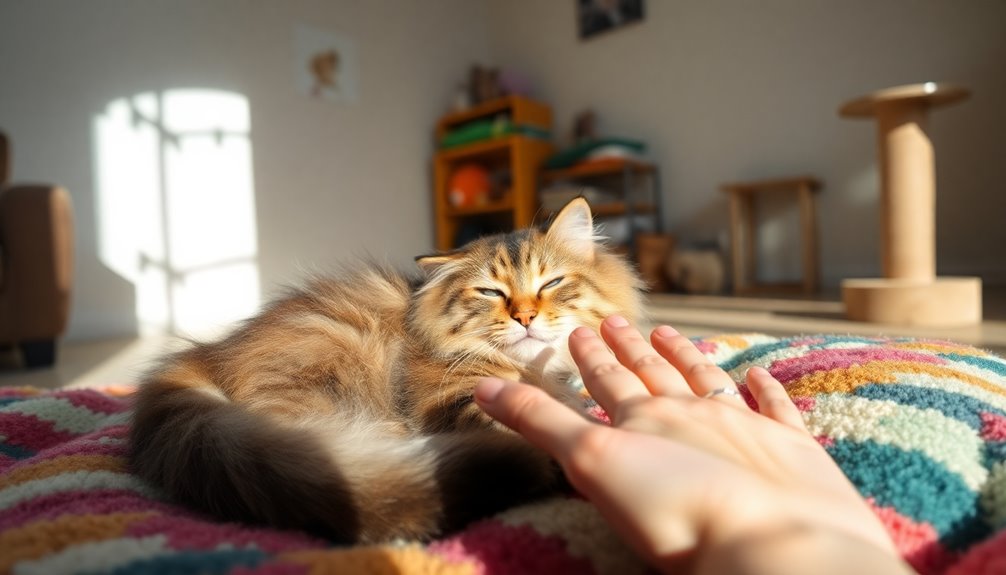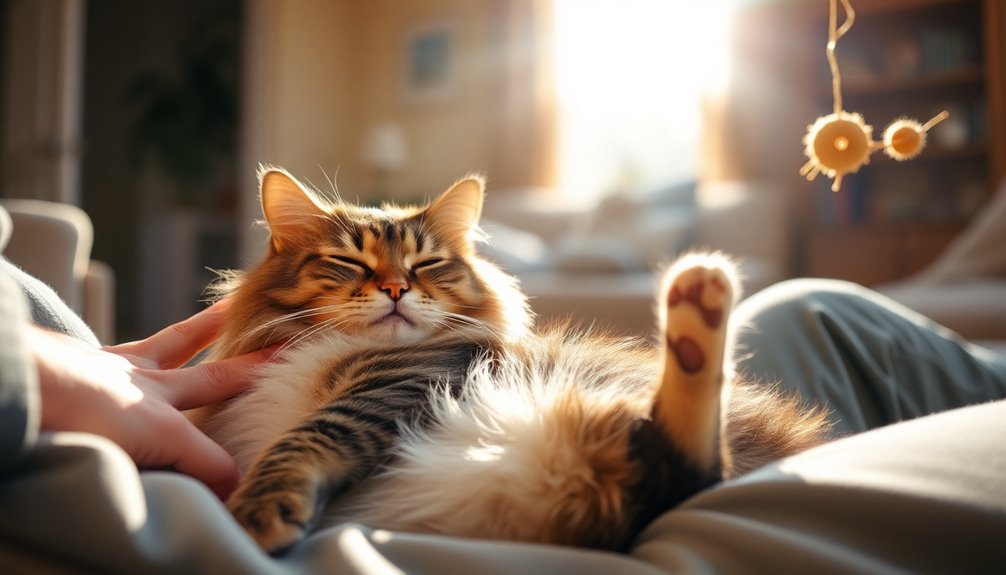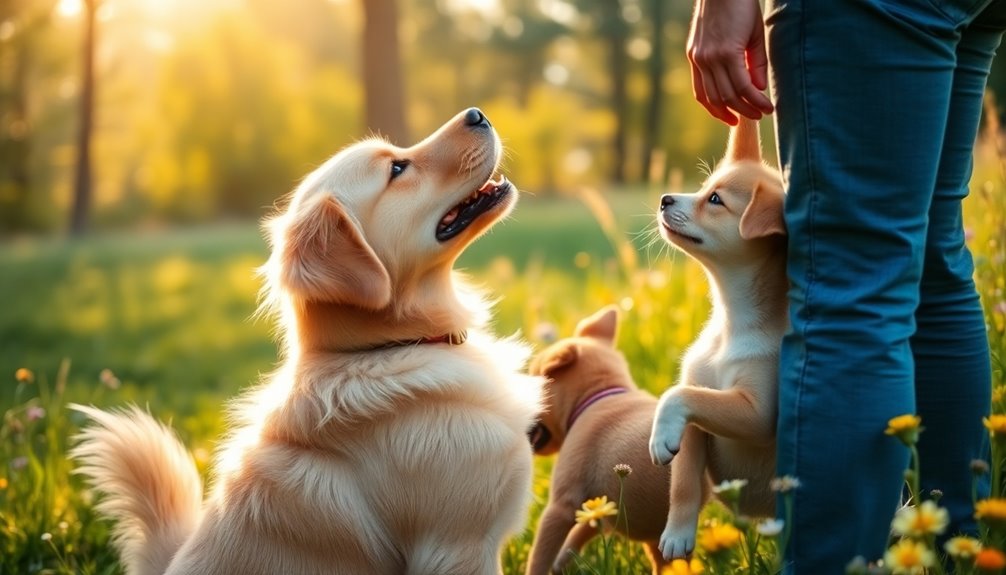Does your cat love you? You might just be surprised by the signs of affection they display. When your feline buddy follows you around or curls up in your lap, it shows trust and comfort. Affectionate head bumps, slow blinking, and playful love bites are clear indicators of their feelings. If they purr while relaxing or even share some "gifts," they're expressing love in their unique way. You'll also notice their trusting belly exposure and grooming behaviors that strengthen your bond. If you look closely, you'll discover even more ways your cat shows they care.
Key Takeaways
- Cats demonstrate affection by following you around and seeking your company, indicating a desire for companionship.
- Head bumps, slow blinking, and kneading are affectionate behaviors that signify trust and emotional connection.
- When a cat exposes its belly, it shows a high level of trust and comfort in your presence.
- Purring serves as a comforting sound, reflecting happiness and a desire for closeness with you.
- Cats bring you "gifts," like toys or prey, as a sign of affection and sharing their instincts with you.
Presence in Your Space

Cats are known for their independent nature, but when they choose to be near you, it's a strong sign of their affection.
Your feline friend often prefers to be in the same room, even if they don't engage directly. This presence in your space indicates a deep sense of comfort and attachment.
If your cat follows you around the house, it shows they're interested in your activities and crave your companionship.
You might notice them sleeping close by or even on your lap, which reflects their trust in you.
These behaviors highlight that they consider you part of their family unit, enhancing their sense of security.
When your cat seeks your company, it's a beautiful indication of their love.
Comforting Purring Sounds
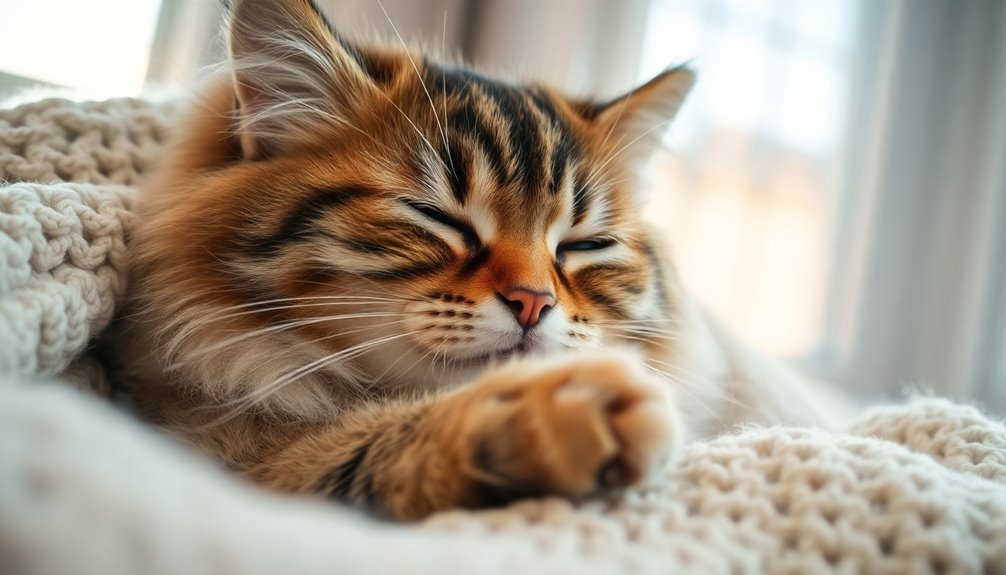
When your cat starts to purr, it's more than just a soothing sound; it's a form of communication.
You should pay attention to the context, as purring can signal happiness or even a need for comfort.
Plus, those gentle vibrations mightn't only make your cat feel good but can also promote healing for both of you.
Purring as Communication Tool
Purring serves as a soothing melody that reflects your cat's emotions and comfort level. When your feline friend purrs, it's often a sign of affection and trust, indicating they feel safe around you.
Pay attention to the sound and context, as it can convey different messages:
- A low, steady purr usually means contentment.
- A higher-pitched purr might signal stress or discomfort.
- Slow, rhythmic purring while being petted shows a desire for companionship.
These comforting vibrations not only express their love but also promote healing and reduce stress, highlighting the bond you share. Interestingly, dogs and their purring sounds also utilize similar communication methods to convey emotions and strengthen bonds with their owners.
Context Matters for Purring
Although purring often signifies contentment, understanding the context is essential to fully grasp your cat's emotional state.
While you might associate purring with affection and relaxation, it can also indicate stress or discomfort. If your cat's purring is accompanied by a tense body posture or hiding, they might be feeling anxious rather than happy.
Pay attention to their overall behavior; kneading and slow blinking can signal contentment. Conversely, if your cat is purring during times of illness, they might be seeking comfort rather than expressing joy.
Health Benefits of Purring
The gentle sound of your cat's purr can be more than just a sign of affection; it actually brings a host of health benefits. Research shows that the frequency of purring, between 25-150 Hertz, promotes healing and reduces stress levels for both you and your feline friend.
Here's how purring contributes to overall health:
- Lowers blood pressure and heart rate
- Fosters a calming environment, enhancing emotional stability
- Aids in the healing of bones and tissues
When your cat purrs, it's often a sign of contentment, but it can also indicate pain or stress. Understanding this complexity can help you better appreciate the soothing sounds that contribute to both your health and your cat's well-being.
Thoughtful Gift Giving
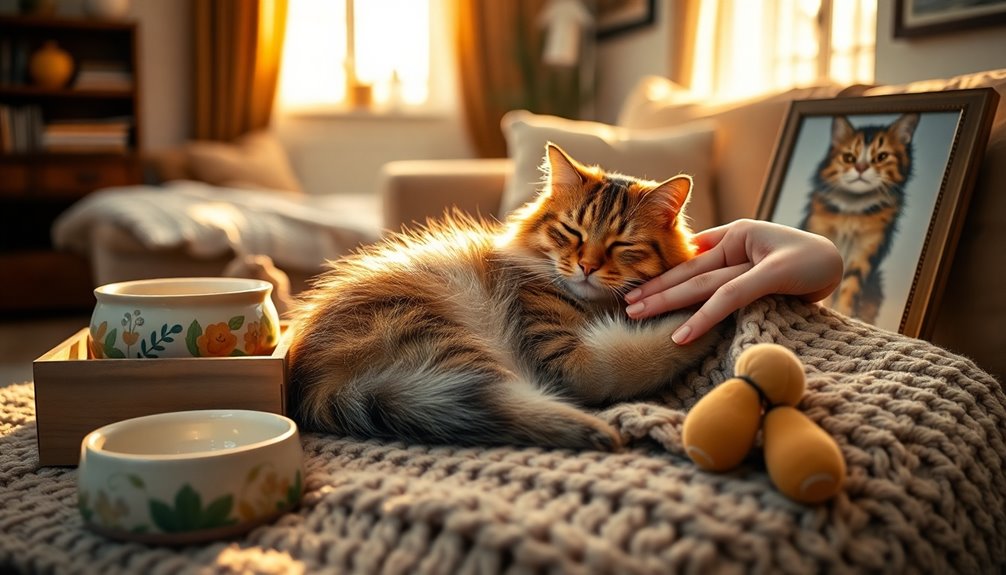
When your cat brings you a "gift," whether it's a toy or a captured prey, they're sharing a piece of their world with you. This behavior shows their instinct to teach and bond, much like a mother cat does with her kittens. Recognizing these gestures can strengthen your connection and affirm that you're part of their family. Additionally, this affectionate behavior can contribute to your emotional well-being, similar to how pet therapy enhances the lives of individuals with conditions like dementia and Parkinson's.
Prey Presentation Behavior
One of the most endearing behaviors cats display is their instinctual prey presentation, where they bring you gifts in the form of dead animals or toys. This act reflects their natural hunting instincts and is a clear sign of affection.
When your cat shares their "catch," they're showing you that they consider you part of their family.
Look for these signs that your cat is expressing their love:
- They deliver a toy or a captured animal to you.
- They display pride while presenting their "catch."
- They seem pleased when you acknowledge their gift.
Recognizing this prey presentation behavior strengthens your bond, deepening the trust and emotional connection between you and your feline friend.
Toy Sharing Signals
Although it might seem odd at first, your cat's tendency to share toys is a heartfelt gesture that reflects their affection for you.
When your feline friend brings you their favorite toys or even random household items, they're showcasing their bond and trust. This toy sharing behavior stems from their hunting instincts, where they instinctively want to present their "catch" as a thoughtful gift.
By sharing what they value most, your cat signals that they see you as part of their family. Even if it's just a crumpled piece of paper, the intent behind these gifts is clear: they care for you deeply.
Embracing these gestures can strengthen the connection you share with your affectionate feline companion.
Affectionate Head Bumps

Affectionate head bumps, often called head-butting, are a delightful way your cat expresses love and trust.
When your feline friend gently nudges you with their head, it's a clear sign they feel secure and affectionate. This behavior not only reinforces your bond but also marks their territory with scent from their glands.
Here are a few signs that head bumps indicate affection:
- Your cat approaches you for head bumps when you're relaxing.
- They accompany head bumps with purring or kneading.
- They rub against your hands or body during these interactions.
Slow Blinking Communication

Slow blinking is a charming way your cat shows trust and affection, often referred to as "kitty kisses."
When your feline friend slowly blinks at you, it's a sign that they feel safe and secure in your presence. This non-verbal communication conveys love and can deepen the emotional bond between you two.
Cats typically reserve slow blinking for their owners and other trusted individuals, making it a special behavior that reflects their connection to you.
To reciprocate this affectionate gesture, try slowly blinking back at your cat. They'll likely interpret it as a sign of acceptance and comfort.
Engaging in slow blinking not only enhances your relationship but also fosters a sense of safety and intimacy during your interactions.
Kneading for Comfort

When your cat kneads on your lap or a soft blanket, it's a clear sign of their comfort and affection. This behavior stems from kittenhood, where they kneaded their mother to stimulate milk flow. As they grow, kneading becomes a way to express trust and a sense of safety with you.
Here are a few reasons why kneading is significant:
- Affectionate Gesture: It shows they feel safe and loved.
- Comfortable Environment: They see you or the blanket as a secure space.
- Social Bonding: It mimics grooming, reinforcing their connection with you.
Even if their claws may be sharp, remember that kneading is a positive sign of your cat's emotional state and contentment.
Relaxed Drooling Moments

When your cat starts to drool while lounging comfortably, it's a clear sign that they trust you and feel safe in their environment.
This relaxed drooling often comes during those cozy moments, like when you're petting them or they're nestled in their favorite spot.
However, keep an eye on this behavior; if it becomes excessive, it might be time to consult your vet to rule out any health concerns.
Indication of Comfort
Relaxed drooling moments can be one of the most heartwarming signs of your cat's comfort and affection.
When your cat starts drooling while you're petting or cuddling, it means they truly feel at ease. This behavior showcases their strong bond with you, indicating trust and emotional connection.
Keep an eye out for these signs during relaxed drooling moments:
- Deep purring: It often accompanies drooling, reinforcing their happiness.
- Slow blinking: A sign of trust and affection, as they feel safe around you.
- Relaxed posture: A comfortable cat will lie down with their body relaxed, showing they're not tense.
If you observe this behavior regularly, it's a clear indication your feline friend is content!
Trust and Relaxation
As you observe your cat in moments of relaxed drooling, you might notice a profound sense of trust and security reflected in their behavior.
This endearing act often occurs when they're being petted or nestled in a comfy spot, showing they feel completely safe with you. Relaxed drooling signifies that your feline friend isn't just comfortable, but also expressing affection.
It's a delightful reminder of the bond you share. While it's crucial to watch for any excessive drooling that might suggest health issues, a little drool during cozy moments highlights your cat's deep trust in you.
Recognizing these signs enhances your understanding of their emotional state and strengthens your relationship.
Monitoring Health Changes
Understanding your cat's relaxed drooling can help you keep an eye on their overall health. As a cat owner, it's important to recognize that while occasional drooling signifies affection, excessive drooling could indicate health issues.
To effectively monitor health changes, pay attention to these signs:
- Context of drooling (purring or slow blinking indicates comfort)
- Changes in drooling patterns (could signal dental problems)
- Environmental factors (stress or anxiety can increase drooling)
Trusting Belly Exposure

When your cat exposes its belly, it's a clear sign they've reached a high level of trust and comfort with you. This vulnerable position shows they feel secure, indicating a strong bond and affection between you.
However, don't assume it's an invitation for petting; some cats may react defensively if you touch their belly. Look for relaxed body language, like purring, which reinforces their sense of safety.
Each cat is unique, so understanding their personality is essential. While some enjoy gentle belly rubs, others prefer to keep that area undisturbed.
Respecting your cat's comfort level with belly exposure strengthens your relationship and demonstrates your trust in each other.
Grooming Behavior
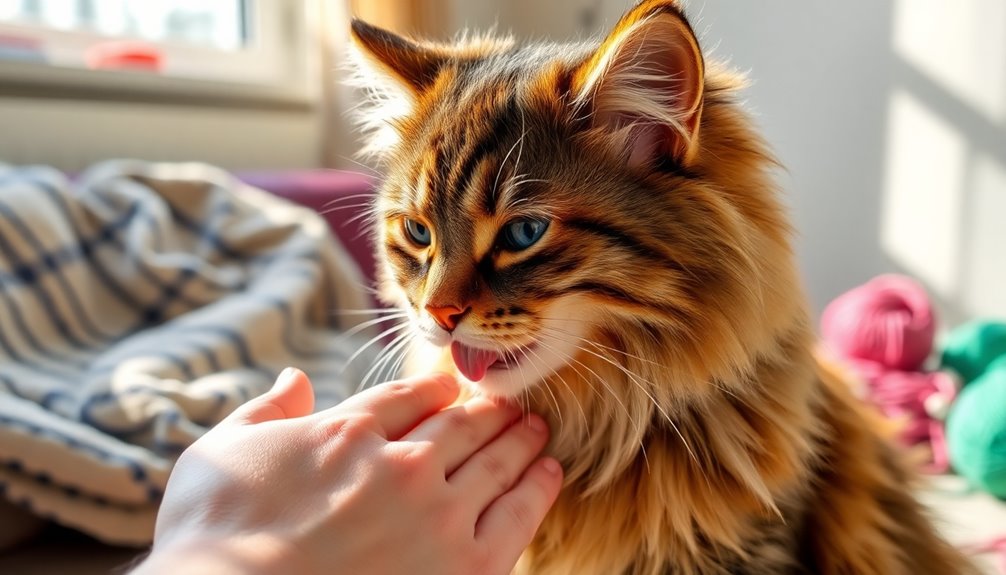
Cats express their affection in various ways, and grooming behavior is a significant indicator of their love for you. When your cat licks or grooms you, it's a sign of trust and acceptance, mirroring the social grooming found in feline communities. This behavior fosters a bond akin to familial relationships.
Here are a few key aspects of grooming behavior:
- It strengthens your emotional connection, acting as a calming activity for both of you.
- Kneading while grooming reflects comfort and contentment in your presence.
- It showcases their natural instincts to care, similar to how they groom their kittens.
Playful Love Bites
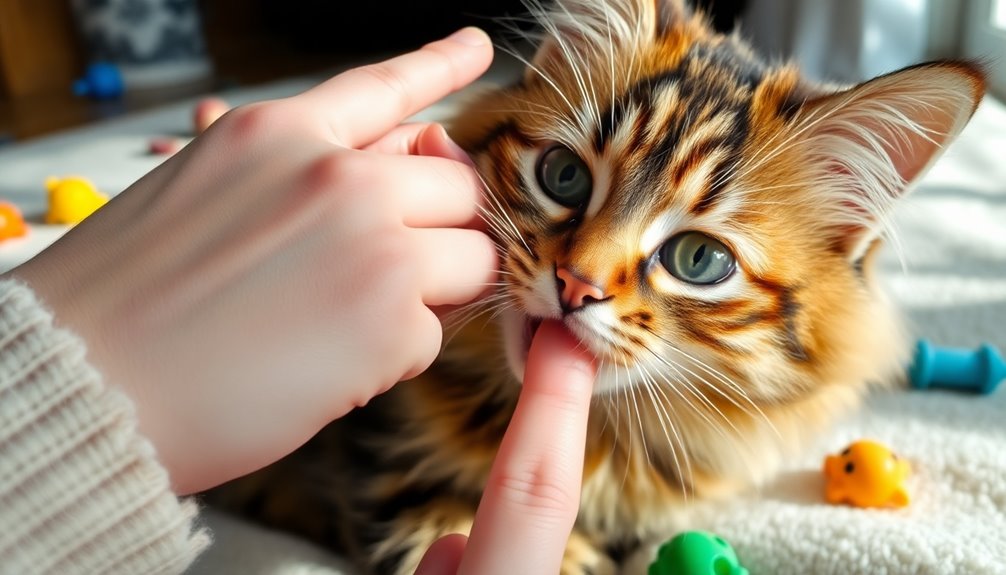
Although it might feel surprising at first, playful love bites are a charming way your cat shows affection.
These gentle nibbles often happen during petting or playtime, indicating your cat's desire for interaction rather than aggression. When your cat playfully bites you, it's a sign of trust, as they feel comfortable in your presence.
Kittens frequently exhibit this behavior as part of their social development, and it can continue into adulthood as a friendly form of communication.
It's important to distinguish playful love bites from aggressive ones; the former are soft and usually accompanied by other affectionate behaviors, like purring or kneading.
Redirecting your cat's attention with toys can reinforce positive interactions and discourage any unwanted biting.
Frequently Asked Questions
How to Tell if You Are Your Cat's Favorite Person?
To tell if you're your cat's favorite person, pay attention to their behaviors.
If they follow you around, greet you at the door, or engage in slow blinking while making eye contact, it's a good sign of their affection.
Notice if they choose to sleep near you or groom you; these actions indicate trust and comfort.
When your cat shows these behaviors, it's clear they've formed a special bond with you.
What Is the Highest Form of Affection From a Cat?
Did you know that 70% of cat owners report feeling a strong bond with their pets?
The highest form of affection from a cat often includes slow blinking, which signifies trust and love. When your cat exposes its belly, it's showing vulnerability, indicating they feel safe with you.
Additionally, grooming behavior reflects a deep emotional connection, as does head-butting, which marks you as part of their territory and reinforces your bond.
How Do You Know if Your Cat Is Really Attached to You?
You can tell if your cat is really attached to you by observing its behaviors.
If it follows you around the house, that's a strong sign of attachment. When your cat slow blinks at you, it's showing trust.
You might also notice it grooming you or exposing its belly, both indicating affection.
Additionally, if it greets you with soft meows or purring, it's expressing contentment and a desire for your company.
How Do Cats Show Affection to Each Other?
Imagine two cats basking in the sun, gently grooming each other, their soft tongues gliding over fur. This bonding ritual strengthens their friendship.
You might see them head-butting, sharing scents and marking their territory. When they slow blink at each other, it's a silent message of trust.
Engaging in playful wrestling or snuggling close while they sleep shows their deep connection and comfort, creating an unbreakable bond in their little feline world.
Conclusion
In the end, if your cat shows these signs, it's clear they've got a soft spot for you! Just like a knight in shining armor, your feline friend is there to bring joy and companionship into your life. So, cherish those moments, whether it's a gentle head bump or playful nibbles. Remember, every purr and slow blink is their way of saying, "You're my person." Embrace that bond, and enjoy the love your cat freely gives!
